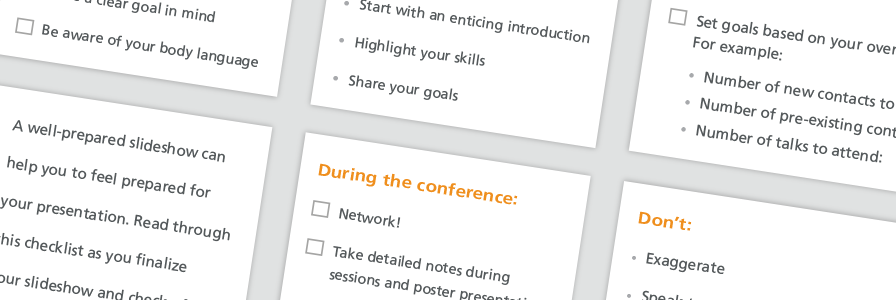Seven Networking Tips for Scientists

Many successful researchers would tell you that networking is important for your career. Networking can help you find opportunities for new collaborations, career advancements, and mentorships.
But the thought of going out to networking events can be daunting.
What if I don't know what to say? What if I look nervous? What if I fail to make a good impression? What if...
With the help of our friend Fane Mensah, Managing Director of the Science Entrepreneur Club, we’ve compiled some best practices for networking. Follow these tips and start building your network!
1. Know Your “WHY"
The more you really know yourself, the easier it is to stand out from others at a networking event. Presenting yourself as just another grad student who is unsure about what they want to do, makes you forgettable. You are more than that, so try to present yourself in a more memorable way.
Ask yourself introspective “why” questions. Why are you networking? Why do you care about research? Why do you want to stay at or move away from the bench?
Once you know your “why”s, you can prepare in a way that will serve your purpose.
- Prepare your “elevator pitch” or introduction with your “why” in mind.
- Create a LinkedIn profile that speaks to your purpose and passion.
- Try to find out who’s attending that particular event. Are there individuals who can help you with your goals? Read up on their work and prepare a few questions to ask them.
2. Think Ahead and Practice
You make eye contact with another attendee. You shake hands and introduce yourselves. Now what? What should you do next?
Avoid awkward silences by thinking of some conversation openers ahead of time. For example, if you’re at a conference, you can ask: “What do you think of the conference so far?” or “What’s your favourite talk?”
You can also prepare answers to commonly asked questions, including “What do you do?” or “ What are you working on?” Think of how you can answer these questions in a way that’s engaging and showcases what you’re all about.
Use every opportunity to practice your conversational skills. Invite a colleague out for coffee, socialize at lunch time and after work, or introduce yourself when you see fellow researchers that you haven’t met before. The more you practice with real people, the more natural and genuine your questions and answers will sound when you’re networking. This authenticity will help you build a connection with other people.
3. Listen and Provide Value
Many young researchers make the mistake of making networking all about them. They attend networking events expecting to reap self-centered benefits such as landing a job interview or finding a new collaborator. Because of this mindset, they end up talking endlessly about themselves and what makes them so great. They can end up sounding self-important and turning off others.
Instead of selling yourself, aim to provide value to the people you meet. This begins with listening more and talking less. Be curious, ask questions, and pay close attention to what others are saying. Think “How can I help them?” or “How can we help each other?” rather than “How can they help me?” You’ll be seen as a collaborative and helpful individual, and you’ll have an easier time building connections.

When you speak to someone much more senior than you, let them do most of the talking, and make sure when you ask questions that they are related to what they have just told you. This is the best way to establish strong relationships as they will appreciate you paying attention. “Active” listening, instead of “passive” listening in these situations is very important.
Aim to bring value to the people you meet. It doesn’t have to be in a big way. Adding value could be as simple as forwarding a related article you just read, introducing them to someone you just met five minutes ago, sharing your experiences, or even offering someone a drink.
4. Ask Questions During Presentations
Asking insightful questions at conference presentations will help you stand out from the crowd of attendees. You’ll be giving people a clear reason to come and chat with you after presentation sessions.
Try and ask at least one question during a panel discussion or presentation prior to a networking event. People will come and speak to you afterwards if they think the question was interesting or if your question is relevant for further discussions. (Believe me, this works every time.)
5. Watch Your Body Language
Your body language has a significant impact on how people perceive you. Be mindful of yours.
Avoid body language that can make you seem nervous, weak, or closed off. These include crossing your arms, slouching your back, moving excessively or fidgeting, or avoiding eye contact. Instead, use body language that makes you seem confident, warm, and open. These are good practices to adopt regardless of whether you’re networking or not.
- Straighten your back
- Smile and make eye contact
- Offer firm handshakes
- Uncross your arms and legs
- Use hand gestures naturally
- Position your body towards the person you’re talking to
Social psychologists have shown that intentionally adopting body language that evokes power and confidence will help you overcome anxiety and fear. So if you’re feeling nervous before a networking event, stand tall and adopt your “power pose”. You’ll feel more courageous and project more confidence while you’re networking.
In addition to watching your own body language, pay attention to the other person’s body language. Are they leaning in and nodding along with what you’re saying? Keep it going or advance the conversation. Are they withdrawn or distracted? Perhaps it’s time to gracefully exit the conversation and connect again another time. Simply saying “It was great meeting you” is a common way to end a conversation.
6. Use the People Around You
You’re not alone. Leverage the people around you at networking events.
Look around the room, and see if you recognize people you already know from other events. If so, make sure you say hello and have a chat with them. The best and easiest way of making new connections is through an introduction by someone that already knows you! Keep in mind to also do the same for others.
This next tip is great especially if you’re feeling a little nervous or if you’re in an extremely crowded event where you can’t get one on one discussion time.
Try to join small groups of people (2-4). One on one is always the best, but small groups are great if you don’t feel comfortable at some point or when you’re not familiar with the crowd. With bigger groups you’ll lose focus. Remember that you should stand out at some point.
7. End with a Call to Action
You met someone and chatted for a while. Then what? Don’t let your newly formed connection end there. Always have a call to action.
If you have already discussed specific actionable items during your conversation, simply reiterate what you have agreed to do before you part ways. But in most cases you can exchange business cards or simply say, “Let’s connect on LinkedIn and keep in touch.”
The most important part of networking is the follow-up, send out a LinkedIn invite or an email the next day (don’t leave it too long, they might have forgotten you) and remind that person about the interesting topics you talked about.
LinkedIn is a more powerful and versatile tool to build your network compared to your pile of forgotten business cards. Being active on LinkedIn will allow you to maintain your connection and stay top-of-mind. For example, you can:
- Send follow up messages
- See their detailed profile information
- Find out if you have contacts in common
- Follow their activities and see their posts on your feed
- Comment on their updates
- Tag them on your post or comment
- Share updates and content with your network
Be sure your LinkedIn profile is up-to-date before you go out to network.
Be Courageous
These tips will help you be prepared to network, but they won’t help you if you can’t muster the courage to go out and apply them. Be bold and put your best self forward. Good luck!
Related Content
10 Tips for Attending Scientific Conferences
Plan ahead and be prepared for the next conference you attend to ensure you’re maximizing the benefits.
Present Your Research—Fearlessly!
Tips on how to present data to an audience, and feel comfortable doing so.





